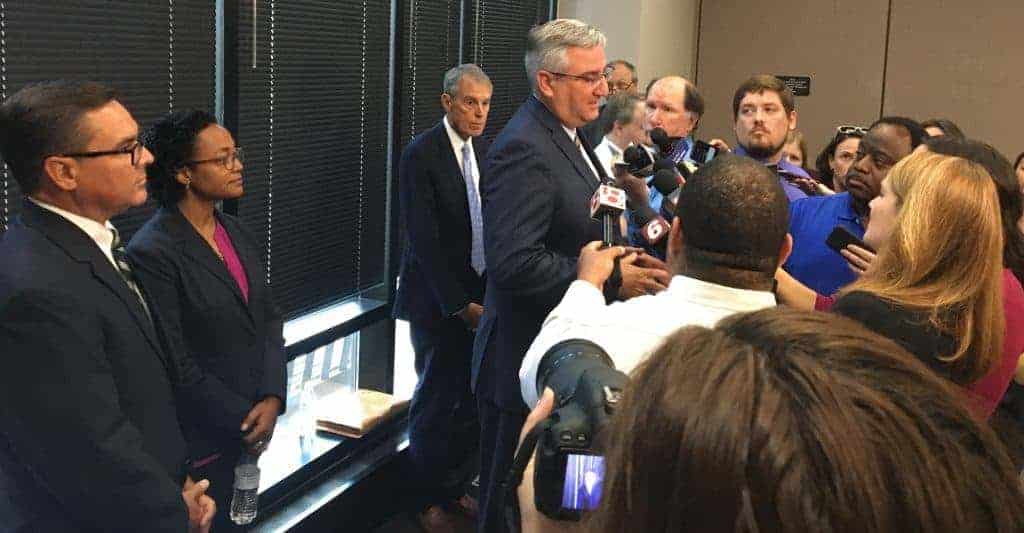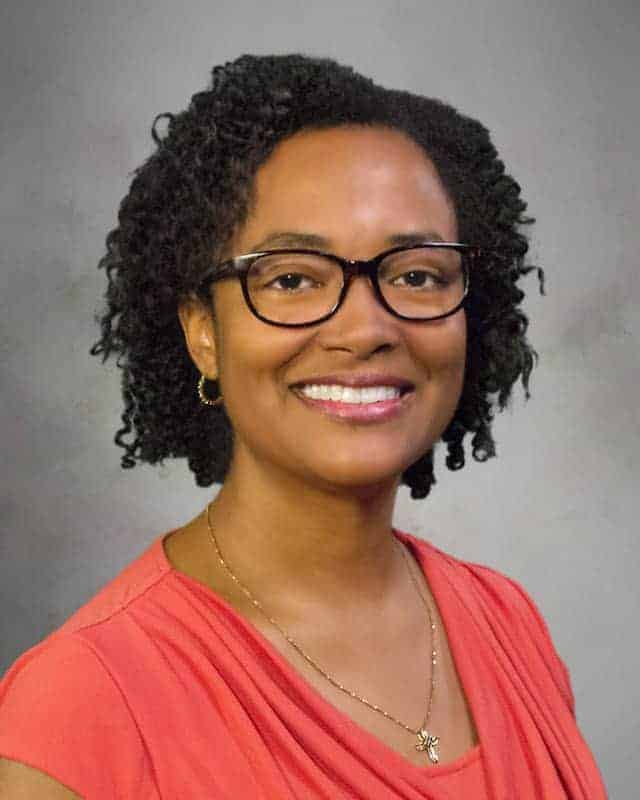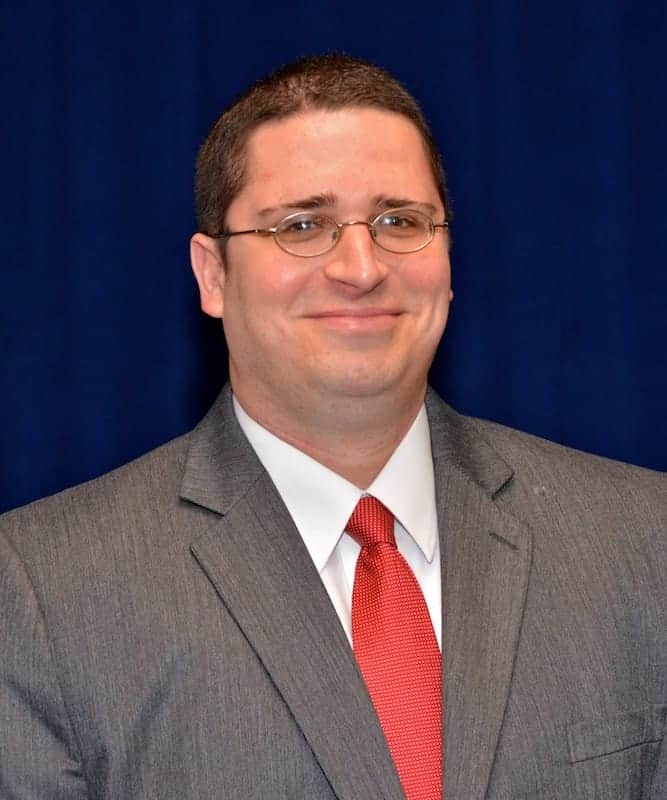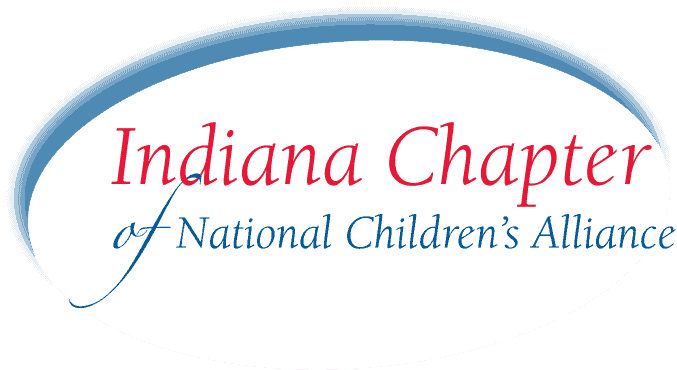
On the third floor of the east tower at the Indiana Government Center, rows of cubicles fill an office floor designated for the Indiana Department of Child Services. The dozens of people sitting in this office are only a fraction of the hundreds of family case managers, caseworkers, supervisors and support staff DCS has positioned around the state.
Near the back of the floor, Terry Stigdon stands in her office. Its modest size and view are surprising. Visitors get a glimpse of Washington Street and a small row of other office buildings. This is surprising considering the responsibilities heaped on her desk. Stigdon, who has been the director of DCS since a high-profile resignation left the agency leaderless in December, seems well aware the work DCS has to do is far from ending, but may be near the start of a new beginning.
Never-told victories
Since Frank O’Bannon served as governor in the late 1990s, Indiana’s child welfare workers have faced the same problems as every other state agency and nonprofit: too little money, too little time and too few people trying to do too much.
Administrative action has been taken over the years to assess and improve Indiana’s child welfare productivity and efficiency. O’Bannon and his successor Joe Kernan had independent reviews conducted. Mitch Daniels moved today’s DCS out from under the Family and Social Services Administration. Mike Pence pushed for more caseworkers with $7.5 million in supplemental funding in 2015. Pence also worked to fend off a lawsuit from the ACLU alleging DCS’ caseworkers were vastly overworked. Indiana law says caseworkers should have no more than 15 cases at a time. The ACLU alleged caseworkers, under then-Executive Director Mary Beth Bonaventura, were routinely pushing 40 or more.
Seemingly every year more high-profile deaths of children splashed across screens and print. Each death sowed more fear into the ranks of caseworkers, which suffered turnover as high as 30% as staff fled for their own health and mental well-being. All while families across the state became increasingly isolated from themselves as a shaky economy, drug abuse, and high stress caused people to shirk responsibilities to children.
In December 2017, former DCS director Marybeth Bonaventura resigned. In a high-profile resignation letter sent to Indiana media outlets, Bonaventura said “children will die” if Gov. Eric Holcomb and the Legislature didn’t act.

In January 2018, Gov. Holcomb ordered a new independent audit and review of DCS. The State chose the Alabama-based Child Welfare Policy and Practice Group (CWG) to find out what DCS needed. He appointed Terry Stigdon as the new director and, after the assessment was released, the pair chose former Boone County Prosecutor Todd Meyer as the new associate director in charge of implementing the recommended changes necessary to improve DCS.
If the leadership team can succeed, this could mark the end of what many have to believe was the bleakest time inside DCS. A series of twilight years where light and dark intertwined in a period of never-told victories and heartbreaking casualties.
It would mark the start of a new beginning.
Nothing is impossible
Back in Director Stigdon’s office, she, Meyer, and DCS Chief of Staff Eric Miller came together to talk about what’s changed, what’s changing, and what’s going to change at DCS.
“There’s been a report [on DCS] every year for about five years,” says Stigdon, “But this is my wheelhouse,” she adds with an excited smile. “When you start looking to make improvements in any type of organization and making the experience better for people who do the work and those that receive the work — that’s my passion. And I’ve learned the passion of everyone in this agency.”
“We didn’t know how many recommendations would come of the CWG report,” says Stigdon. “We don’t want to lose sight of them because they’re child welfare experts,” says Stigdon.
Previous DCS reports have focused on different areas, like finances or management. “But this report from CWG is the first of its kind in breadth and depth”, Miller said. CWG has successfully worked with similar agencies in Iowa, Arkansas, Arizona, Oklahoma, Allegheny County, Pennsylvania and many other states and municipalities. DCS plans to draw on success found in those areas wherever possible.
“We are reaching out to other state child welfare leaders and asking them how they got to where they are today,” says Stigdon.
While traveling to Chicago for a conference recently, Miller recalls, “I met with leaders from Arkansas, and they were explaining how things have gotten so much better two to three years after implementing CWG’s recommendations.”
I met with leaders from Arkansas, and they were explaining how things have gotten so much better two to three years after implementing CWG’s recommendations.
It’s clear DCS and State leaders are impressed by the thoughtfulness of CWG’s report and assessment here and elsewhere. Indiana is not the first state to encounter problems with how child welfare and protection is handled, and DCS’ leadership seems keen on ensuring Indiana will face up to challenging questions and difficult problems.
For outsiders observing the change of an organization, especially a government organization, the pace is often frustratingly slow. And in a state whose residents can generally be described as suspicious of government — particularly the kind emanating from Indianapolis — promises of change are easy to dismiss. The kinds of improvements DCS is working through are no less challenging, but there are recommendations made that are already in motion.
“The decentralization of decision-making has started,” says Stigdon, referring to a CWG recommendation that DCS work harder to engage workers outside the central office. “Advisory groups for family case managers and case workers are also underway,” she adds. These internal advisory groups, the agency hopes, will give employees a venue to deflate problems that contribute to the “culture of fear” that CWG found has dominated the department’s workforce. “Their work is going to change over time, but right now it’s focused on ensuring employees are heard, because if you’re going to be doing some work, it’d be nice to have a voice in how it’s done,” she adds.
Another working group is being formed, too, “to bring external stakeholders together to provide input on making improvements,” says Stigdon. Here again, DCS hopes this will bring together nonprofit providers like Indiana’s Child Advocacy Centers and partners like Connected By 25, plus other state and federal agencies.
Stigdon says partnerships with nonprofit and third-party providers, including Child Advocacy Centers, will improve as the agency improves. “The services CACs provides are important for kids. And we have many providers that provide services to kids through or alongside DCS. As we move forward as an agency, we are going to ensure our family case managers understand what resources are available to them based on where they’re located. How we partner with our providers will improve,” she says.

“For as long as there are children in need of mental and physical health screens and victim advocacy, and for as long as DCS caseworkers need safe, child-first facilities to take children for forensic interviews, Indiana’s CACs will be here,” says Indiana Chapter Director Jan Lutz. “We’ve had a great working relationship with hundreds of caseworkers and family case managers over the years and will continue to do so.”
Miller notes, “The supervisor (to family case manager) ratio is coming down to 1-to-5. We won’t be there until 2019, but we’ve been working hard on hiring more supervisors.”
The reason for the year-long wait is because DCS can’t post a job ad to immediately increase the ranks of supervising family case managers. Family case managers require training and experience as a caseworker first. “Those family case managers have to gain experience to become a supervisor, so we can’t deplete our entire workforce to make everyone a manager. That has to take time,” says Stigdon. DCS says it is also working to bring more attorneys on board to help the agency handle its caseloads more efficiently.
In Stigdon’s view, “There is no CWG recommendation that is impossible.”
Redefining neglect
Indiana’s caseload of abused and neglect children has ballooned compared to every other state in the US, raising eyebrows in legislative circles. According to CWG, this could be due in part to a stringent legal definition of “neglect”, increasing rates of legitimate neglect and abuse, and the culture of fear that looms over caseworkers and healthcare providers.
That culture of fear coupled with Indiana’s mandated reporter law that requires everyone to report a suspicion of abuse has led nurses, doctors, caseworkers and others to report otherwise routine bruises and bumps they notice.
The Indiana Child Abuse Hotline (1-800-800-5556) and 911 are the only legal ways to report abuse in Indiana. The Hotline is staffed around the clock and operators are trained to help screen out cases that don’t meet a standard for follow-up. But shades of gray cloud every situation.
“There’s a risk when we err on the side of caution. And that risk is taking a child out of a home, perhaps prematurely, which is a significant trauma to kids,” says Stigdon. Current research from child psychologists suggest removing a child from their parents and placing them in another home — even that of a relative — can be as traumatic as the event that prompted the move. The scars of such a move can lead to tumbling school attendance, anger and bullying, and depression. That starts a child on a vicious downward cycle that can last a lifetime. “That’s why we have to make sure the definition of everything we do asks: ‘is the child safe?’ “We don’t want to be a part of the trauma on children,” says Stigdon. “I had a family case manager say to me the other day, ‘This is such a huge burden’, and that sounds bad, but that tells me they ‘get it’, and they want to make the right decision,” she adds.
More than 7,000 children were removed from their homes in 2017 because of the presence of drugs, putting Indiana in the dubious position of having administratively removed the greatest number of kids out of their homes than any other state in the country. Recent debate has led some to assume the law is not able to discern the difference between a first-time marijuana user and a first-time methadone user. As further decentralization churns along inside DCS, these sorts of decisions are left to the caseworkers and family case managers working in a community and alongside families where they live, and highly trained family case managers evaluate those situations on an individual basis.
“What we’re always looking at is, ‘is the child safe where they are?’” says Stigdon.
Along with a redefinition of “neglect,” some other changes recommended by CWG will have to come from the Legislature. These include a change in initial assessment response times of one hour, caseload standards and extending funding for children in care to the age of 23. The Legislature will have to agree that legal adulthood may begin at 18, but there is still development and challenges in becoming a productive member of society that often extends to the age of 21 or 23 years old.
If one thing is clear, there is no knowable magic dollar amount for guaranteeing DCS’ success or any one child’s success in life.
Taking care of the people doing the work
We have to take care of the people doing the work, so they can focus on the people we serve.
In June, Gov. Eric Holcomb announced plans to set aside $25 million from the state’s surplus to bolster child welfare. That money is earmarked for improving employee compensation to market rates, among other initiatives. These funds will, the State hopes, bolster staff salaries and support other programs aimed at helping DCS succeed.
Becoming a caseworker in Indiana takes nearly as much training as becoming a police officer, on top of the Bachelors-level education that applying to become a case manager in Indiana requires.
For 12-week stints, new caseworkers travel as a cohort through DCS’ training. It’s an intense program that DCS is immensely proud of through a partnership with the IU School of Social Work. The nationally recognized program is a model for other states and a boon for IU.
Much of that training happens in Indianapolis, however. This presents difficulties for aspiring caseworkers who suddenly find themselves away from their own homes and families as they are housed — at DCS’ expense — in Downtown Indianapolis.
Additional recommendations from CWG include developing regional training so caseworkers aspiring to work in other parts of the state could train closer to their home. For instance, a new caseworker who lives in Columbia City could work and train in Fort Wayne.
That training period incurs a lot of time and expense for everyone. And despite having a world-class training program, there is the persistent employee turnover problem. Stigdon hopes that change, along with the coming increase in salaries for many front-line workers, will turn the tide on the agency’s retention rates. More than a third of DCS workers leave the position with their first year or two on the job, CWG found.
“We have to stop that,” says Stigdon, “We have to take care of the people doing the work, so they can focus on the people we serve.”
A real community issue
Indiana’s Chief Justice Loretta Rush described the work of protecting children as “a real community issue,” but for the average person going about their day-to-day business, this is a vexing question with no clear answer on what, exactly, to do. CWG noted in its report it is not solely DCS’ job to bring order to a disorderly world. Families are complicated, under stress, and always changing. But no matter what circumstances arise, public and private institutions must all rise to meet the responsibility to make sure children are fed, clothed, educated, and most of all: safe.
Speaking as a resident of Indiana and not the head of DCS, Stigdon recalls a conversation she had recently with a group of emergency nurses at an event about the high number of DCS cases where they asked, “What do you want us to do?”
For the nurses in the room, they were likely thinking of a system-wide response as professionals. Stigdon paused for a moment, then asked, “How many of you know your neighbors?” Roughly half of the nurses in the room raised their hand, and the rest looked around sheepishly. “How many of you know their name and actually talk to them?” Most of America frequently looks like the people in that room: a declining show of hands and puzzled looks as if to say, “Who are you?”
For many families of all backgrounds, dropping children off at school or a daycare is seen as enough. For individuals paying taxes that fund food and welfare programs, it is seen as enough. It is not enough.
It’s not unfair to say Americans have become increasingly insular. Most Americans report having fewer than two close friends and only a third know the name of their neighbor. This catastrophic cratering of social connection has ripped away a lot of the personal social safety net that has been in decline since the 60’s and 70’s.
“If one of your neighbors needed help, could you identify that and help them?” Asks Stigdon. “Your contribution to child welfare isn’t calling the hotline,” Stigdon says. “It could be recognizing your neighbor is hungry, and since you’re growing a garden, you could spare plenty of tomatoes and vegetables.”
I prayed for you today
With the work ahead expanding and the public’s restlessness over the state of government affairs, one wonders what attracted Stigdon, Meyer, and all of DCS to the work they have signed up to do. Stigdon gets up like everyone else in the morning, complete with a cup of coffee and her dog, Gus, “ready to take on the day.”
“It is very much a calling. Based on my personal and professional experience, I’m prepared,” says Stigdon, who has a background in nursing. “What a great opportunity I have to help the most vulnerable children and their families together at DCS.”
Stigdon goes on to say with a broad smile, “I would love for DCS to one day have families see DCS as a resource. And we have the people in place today to be able to do that.”
For Meyer, having been a part of Sylvia’s Child Advocacy Center from inception and later serving as president of the board for eight years, all while serving as Boone County prosecutor for fifteen, “It was at Sylvia’s CAC I discovered my desire to work with child welfare,” he says.
Stigdon, Meyer, Miller and the rest of DCS are all hyper-aware they can’t do everything and recognize staff members know there are times DCS will have to intervene in a child and family’s life, often permanently altering their relationships. But there is an increasing emphasis on prevention, too. DCS is forever seeking ways to provide help and keep children and families from coming into the system in the first place.
Placed in the back of Stigdon’s office is a small note taped to a whiteboard. It reads simply, “I prayed for you today.” Because like everyone else, they are humans helping humans in a messy, disorderly world. As Stigdon and Meyer steer DCS on a journey that is just beginning in a new direction, they know they can’t fix everything. But you come away knowing they have pledged to do their best to make DCS better, and in turn, to bring an end to suffering and be the beginning of hope to thousands of Hoosier children every year.

